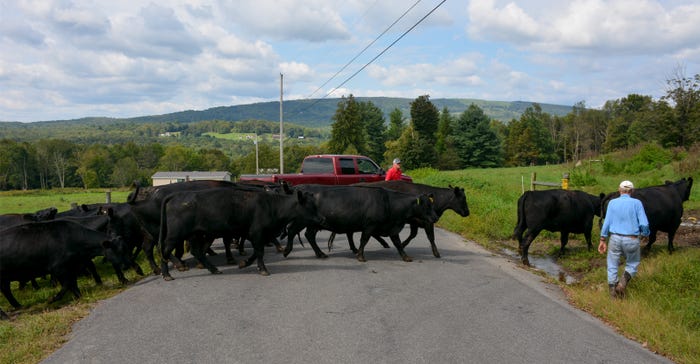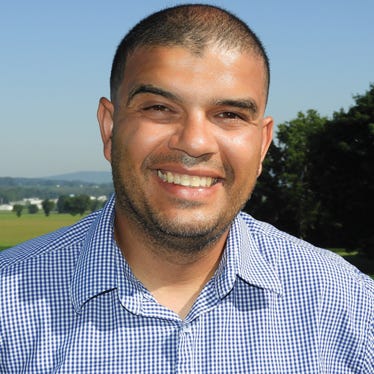
ON THE MOVE: Richard and Phil Coombe have transitioned Thunder View Farms to focus on better genetics and quality meats for the freezer trade.
In 1959, Phil Coombe purchased five Angus cows and calves as a modest addition to his family's farm. But this was the unofficial start of Thunder View Farms in Grahamsville, N.Y., now run by two generations of the Coombe family.
The farm has become known for its environmental stewardship, and earlier this summer was selected as one of six winners of the Environmental Stewardship Award, sponsored by Corteva Agriscience, McDonald's, the USDA's Natural Resources Conservation Service, U.S. Fish and Wildlife Service, and the National Cattlemen's Foundation.
Being within 100 miles of New York City, the family has dealt with many challenges to the farm's future. But the fact that they are still in business, and thriving, is a testament to their willingness to change.
Expansion takes hold
As Phil Coombe, now 82, laid the foundation for the farm's future, Richard Coombe, his brother, returned with an eye on expansion.
"I came back and we expanded the herd," says Richard Coombe during a recent sit down.
As many neighboring farmers were retiring, Coombe says it opened an opportunity to expand.
"We built a lot of grassland, did a lot of work strip cropping, grew corn at the time and put in subsurface drainage," he says. They used to grow 150 acres of corn, but a transition to an all grass-based system started in the '90s.
They farm a total of 1,500 acres with five Angus herds spread throughout the farm.
Another change took place when Richard Coombe's son, Rick, joined the business. His addition changed the farm's focus, emphasizing more on larger ribeye, more marbling and less back fat in the meat.
The herd has expanded from 60 cows to 144 bred cows this year.
Finding a niche
"Our niche has been to really improve our freezer trade, which my brother and I have had throughout, but it was sort of minimal," Richard Coombe says.
He anticipates sending at least 100 animals to slaughter next year, selling 200 halves.
"It's been a really big increase and the reason is just the quality of the meat. It's just incredible," he says.
Why? Better genetics and slaughtering at a younger age.
"Our niche is quality rather than quantity," he says.
Cattle are slaughtered at between 13 and 18 months. They are fed an all-grass forage diet, at better than 20% protein, and finished on grain for the last 60 days.
Weaning weights have gone up over 200 pounds, he says, with most calves weaning at 750 pounds and some weaning as high as 860 pounds.
Most of the meat grades out Prime, with the farm's goal being 75% Prime according to Rick Coombe.
Richard Coombe says the smaller animals are more tender and are more efficient feeders.
"We can bring them up to 1,100 to 1,300 pounds easily," he says. "When the customer is paying $3.10 a pound, plus cutting and wrapping, they don't want to pay much more than $1,200 to $1,300. We could not market to our customers the big steers."
At that rate, Richard Coombe says, his customers would likely have to pay over $2,000 a side.
The meat is sent to a federally inspected plant almost two hours away in Otego, N.Y. It is sold on the farm as well as at a local gas station. They also sell five Sundays a year at the Bethel Woods Center for the Arts, located at the site of the original Woodstock music festival.
Ninety percent of the cows are run through AI, with the conception rate being 60%. The remaining 10% are bull bred with one of six existing bulls on the farm.
They breed for docility, he says, and cull any animal with an "attitude."
While they've mostly operated as a closed herd, the farm has absorbed other high-quality herds, including part of the Equity Angus herd.
"Equity Angus is very well-known outside of Syracuse, so that gave us even better genetics," he says, adding that one of the animals was in the top 10 nationally for marbling and less back fat.
Absorbing the Equity herd has also enabled the family to do some showing. Animals have won awards at the Atlantic National Angus Show and the New York State Fair.
Adapting to survive
The early 1990s were a tough time for farmers in the Catskills. New York City, which gets nearly all its drinking water from area reservoirs, wanted to impose strict regulations on farms, such as banning runoff from grazing areas and requiring 250-foot setbacks from streams.
"It would have taken about 50% of my fields, half of my pastures and would have put me out of business," he says. The Rondout Reservoir is four miles from the farm.
Coombe was a member of the state assembly at the time and placed himself in the middle of the fight between the area's farmers and the city.
The regulations never went through. Instead, Richard Coombe says, city officials realized that keeping farms around was better for the environment than putting them out of business. It was also cheaper than paying more than $4 billion to install a water filtration plant.
Richard Coombe became the first chairman of the Watershed Agricultural Council, a nonprofit that works with farmers on putting in best management practices to cut down on nutrient pollution. Most of the council's funding comes from the city.
At Thunder View Farms, the program has helped pay for heavy-use pads to feed cattle along with self-feed silage bags that can feed 20 to 25 cattle at each end.
"It's worked very, very well because we catch manure from there and we can take that manure and spread it, and that lowers our fertilizer bill," he says.
It's also helped pay for a gravity-flow system that delivers clean water to all the pastures as well as numerous 35-foot buffers around streams to keep cattle out.
"That allowed for us to keep the cattle out of the streams and rotationally graze," Richard Coombe says.
The farm also participates in a nutrient management credit program where, in exchange for lowering nutrient runoff, the council provides credits to buy new equipment or put in manure storage.
Getting this help, though, comes with its caveats. Richard Coombe says he is restricted to where he can spread manure, and he must inform WAC officials if he plans on relocating a pasture or building on the land
City officials test the farm every three years for nutrients with a particular eye on phosphorus. Too much phosphorus in waterways can lead to excess algae, which can kill animals and degrade water quality.
Farmers are also required to develop whole-farm management plans to participate in the program.
"Our bottom line is much better because the city is here, but it comes with a price in the sense that we can't do anything substantial without asking," Richard Coombe says.
Passing the torch
In 2012, the Coombes put 732 acres under permanent easement. Richard Coombe, 76, says the money was used to pay down debt and to transfer the farm to the next generation.
They also installed a wind turbine and solar panels to provide electricity to the farm shop and their freezer beef business. They also lease out land for hunting.
A man-made lake that took seven years to excavate was completed in 2011. Richard Coombe says the idea was to give the next generation the option to start an agritourism business in the future.
But challenges remain.
"Probably the biggest limitation for us is we just can't supply enough," he says.
They started fall calving to spread out the calving schedule year-round, but the labor required "was killing us," Richard Coombe says. Transitioning to a larger herd has also affected the bottom line. He says they are struggling in terms of cash flow and have started to sell genetics to other producers.
Still, Richard Coombe is confident that the business is in good shape for the future.
"I think as time goes on we will have transferred onto the next generation a sustainable business," he says.
Watershed BMPs
The Watershed Agricultural Council deals with about 280 farms in the eight-county New York City watershed, according to Nate Townsend, the council's whole farm planning coordinator.
The program has grown mostly by word of mouth, he says, as most farmers contact the office upon hearing of projects other farmers have done.
"The relationships with the farmers and getting the farmers on board is, by far, the hardest part," he says. "So local control is important. Farmers drive this whole program. It's the whole reason it even works because they buy into it."
The program is funded by the New York City Department of Environmental Protection, which manages the city's water supply system. Drinking water flows from more than a dozen reservoirs and lakes in the region through a complex series of aqueducts and tunnels down to the city.
The council gets $2.2 million in annual funding from the city, but that is scheduled to go up to $4 million a year over the next six years to speed up implementation of BMPs. Townsend says it can take five-plus years for BMPs to get installed because of funding and staffing issues.
Funding also comes from federal programs such as the Environmental Quality Incentives Program.
Townsend says the program funds around 200 BMP installations on farms every year, ranging from animal stream crossings to manure storage facilities.
About 90% of large farms in the eight-county region, defined as grossing more than $10,000 in annual ag income, participate in the program, Townsend says.
About the Author(s)
You May Also Like






